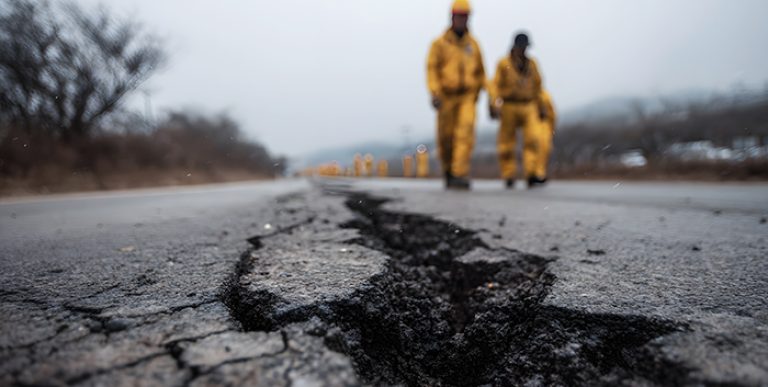Earthquakes can strike without warning, disrupting operations, endangering lives, and damaging property. For businesses, being unprepared can result in devastating financial and safety consequences. Creating a clear earthquake preparedness plan is essential for safeguarding your employees and maintaining business continuity.
This article provides essential earthquake safety info, practical steps for an earthquake disaster plan, and best practices for earthquake procedures in the workplace.
The Importance of Earthquake Safety Procedures in the Workplace
FEMA estimates 75% of businesses fail within three years of a disaster because they didn’t have a continuity plan. Many businesses underestimate the impact of earthquakes until it’s too late. Preparing ahead of time can:
- Protect employees from injury
- Minimize downtime and property damage
- Ensure compliance with OSHA and workplace safety standards
- Provide peace of mind knowing your business has an effective emergency plan for earthquakes
Without a plan, employees may not know how to respond to an earthquake, leading to confusion and increased risk.
Creating an Earthquake Procedure Plan
A documented earthquake preparedness plan outlines the roles, responsibilities, and actions employees must take before, during, and after an earthquake. Having these earthquake procedures in the workplace ensures:
- Everyone understands what to do in an earthquake drill
- Evacuation routes and assembly points are clear
- Managers and safety leaders can carry out earthquake emergency procedures in the workplace efficiently
By formalizing your earthquake procedures, your business demonstrates a commitment to safety in an earthquake and helps save lives.
Before An Earthquake: Get Prepared
Build Your Preparedness Plan
- Create a written earthquake disaster plan
- Emphasize safe places to “drop, cover and hold on” during earthquake
- Provide fire extinguishers and first aid training
- Practice earthquake drill procedures regularly
- Train staff on your emergency evacuation plan for earthquakes and identify safe locations to meet when the shaking has stopped
- Stock emergency supplies (water, first aid, flashlights, radios)
Ensure Organization Survival
- Identify the critical elements of your business–equipment, communications, supply, IT, employee knowledge and skills
- Make plans to protect, reconstruct and duplicate these elements
- Train staff to carry out these plans in the event of an earthquake
- Make your buildings safer and more resistant to earthquake damage and disruption
- Check with your local building regulatory agency to find out how long structures have been subject to building codes containing seismic design provisions
- Ensure nonstructural items are anchored, braced, reinforced, or otherwise secured
During An Earthquake: Drop, Cover, & Hold On
- Drop to your hands and knees
- Cover your head and neck with your arms
- If you are in danger from falling objects, and you can move safely, crawl for additional cover under a sturdy desk or table
- If there is no obvious solid shelter, position yourself away from windows and close to an interior wall. Steer clear of glass, windows, exterior doors and walls, as well as any objects that might topple. Secure yourself beneath a reliable surface and remain there until the tremors cease.
- Grab onto any sturdy cover and stay under it until the shaking is over
- Stay put, don’t run outside, and don’t use doorways since they won’t shield you from falling or flying objects
- If you’re already outside, head to a wide open space, keeping clear of buildings and power lines
After An Earthquake: Response & Recovery
Post-Earthquake Response and Recovery
- Implement Emergency Response & Recovery plans
- Locate all staff and visitors, then evaluate their safety and health
- Treat and respond to medical emergencies
- Control critical operations, including flammables, per your safety plan
- Beware of potential aftershocks
- Evacuate the building if unsafe, following the emergency evacuation plan for earthquakes
- Check for hazards like gas leaks or structural damage
- Activate your earthquake emergency procedures in the workplace to resume operations safely
Conduct An After-Action Review
- Evaluate how your organization handled the earthquake
- Identify areas for improvement in preparedness and response
- If repairs or rebuilding are needed, make sure to fix structural weaknesses and follow seismic building codes
- For damaged contents, improve how items are secured to prevent future losses
- If employees weren’t fully prepared, increase safety training and hold drills more often
Further Resources
For more helpful resources, access:
Easily access these helpful online disaster resources:
- Business Continuity | www.ready.gov/business
- Emergency Alerts | www.ready.gov/alerts
- QuakeSmart | www.fema.gov/quakesmart
Earthquakes are unpredictable, but your response doesn’t have to be. By investing time in developing and practicing an earthquake disaster plan, your business ensures that employees know how to prepare for an earthquake and how to respond to an earthquake calmly and effectively.
A strong earthquake preparedness plan is more than compliance—it’s a commitment to protecting lives, property, and the future of your organization.

